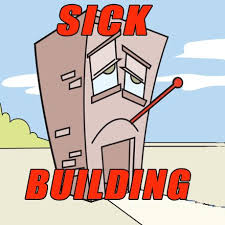 December 2016
December 2016
Sick Building Syndrome is a way to describe buildings where a significant number of people experience health problems. Illnesses appear related to how much time is spent in a specific building but no illness or cause can be identified.
The first occurrence of Sick Building Syndrome was in 1977 when a strain of bacteria was found breeding in the cooling tower of a Philadelphia hotel air conditioning system. Thirty-four people died from this outbreak – a severe form of pneumonia – and over 200 individuals required treatment. It became known as Legionnaires Disease after delegates to a conference staying at the hotel.
Sick Building Syndrome is used to describe a building where many occupants experience health and comfort problems without being able to identify a specific cause. The identified common factor tends to be time spent in the building. It may relate to exposure to contaminants in the building. This may result from poor air quality relating to temperature, humidity or ventilation. Lighting has also been found to cause such problems as have chemicals and poor maintenance.
Some building materials may release gases that affect indoor air quality.
Maintaining a healthy building requires cleanliness and routine maintenance. Do not allow water leaks to persist. Regularly replace filters. Ventilation and humidity need to be adequately controlled. Check the HVAC system for mould growth or pest infestations. When Sick Building Syndrome symptoms persist it may be necessary to measure humidity, temperature, carbon dioxide level and air movement in affected areas of a building. These can be compared against general building standards or unaffected areas of a building.
Symptoms of Sick Building Syndrome
- General unwell feeling when in a building
- Unidentifiable odours
- Headaches, fatigue, rashes or other physical symptoms
- Flu like symptoms
- Allergies
- Eye or nasal irritation
- Symptoms experienced by 15% – 20% or more of building occupants when in the building



